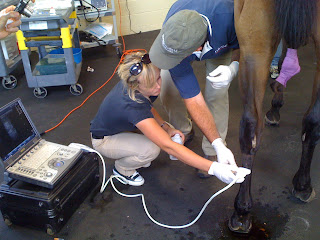Here, however, I resurrect the theory as it was first designed. It is important to remember that not all owners will experience all stages in the order in which they are presented. Indeed, swings from anger to acceptance to denial are not at all uncommon. All rehabbers, however, can expect to experience at least two of these stages.
1. Denial
Riders, upon hearing the news of a horse's season- but not career- ending injury, are often oddly cheerful. This is temporary. They may make comments such as, "it's only a 20% tear, thank goodness-- he'll get better in time for that fall destination event!" or "I'm really OK with this because I needed more time to take up scrapbooking/ knitting/ spelunking," or "think of all of the flatwork we can get done!" The horse's mane remains pulled and the tail clipped and banged.
2. Anger
As the reality of the horse's injury becomes evident, the formerly cheerful rider becomes rageful and bitter. "But he was so fit-- how could he have pulled that?" "What on earth was he thinking, screaming around the corner of his pasture like that?" "Why do I get all the accident-prone ones?" This is the stage during which the rider or owner is less-than-perfect company, due to tiresome self-pitying and indignant tirades. He or she might respond disproportionately to the slightest setback: for example, one particularly disturbed rider was reported to have lost most of her hair because she tore it out upon hearing that her rehabbing horse trotted two steps and then bucked in place-- twice-- in his tiny outdoor pen.
3. Bargaining
This stage seems entirely reasonable at first. In exchange for money, the rehabber obtains a diagnosis and treatment plan from the veterinarian, stall toys for the horse, and extra services such as hand walking, wrapping, wound dressing, stall cleaning, and cold therapy. As time goes on, the rider begins to believe that the more money that is thrown at the injury, the faster it will heal. Expensive consulting veterinarians are brought in to perform expensive treatments. Fancier toys are placed in the stall, and failed attempts are made to pay others to ride the pent-up mount on her
4. Depression
Eventually our rehabber comes to the realization that the season is definitely over, the horse is bored out of his skull in the stall and there is nothing she can do about it, and she is broke. She might observe friends driving off to competitions and returning with stories of adventure, or find herself obsessively checking the competition organization's website for next year's show dates, and find that both leave her numb and unfulfilled. Responses might include endless Facebook and horsey bulletin-board surfing, considerations of quitting riding, ice cream and cookie binges, or the refusal to get out of bed. The horse's mane gets long and shaggy and her tack grows mold. It is important to treat the rehabber with sympathy and understanding at this time, and not try to talk her out of this difficult, but all-important stage.
5. Acceptance/ Resignation
This is the crucial stage in which the rehabber comes to the understanding that she must rehab the horse step-by-step, literally. She purchases a new stick of Sadl-Tite, puts the horse on a calming supplement, and surrenders to the simultaneous boredom and excitement of thirty minutes of walking a fresh horse on straight lines in a lovely November
*With a nod to Not That Kind of Doctor!













